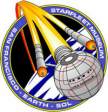 |
 |
Dragon-Class Heavy Cruisers
![]() Diagrams
Diagrams
![]()
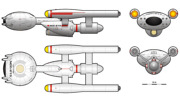 Four views |
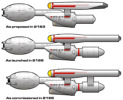 Design evolution |
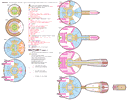 Deck plans, part 1 created by Allen Rolfes (see notes) |
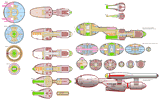 Deck plans, part 2 created by Allen Rolfes (see notes) |
![]() Scenes
Scenes
![]()
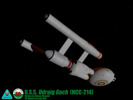 3D scene created by Andrew Hall |
 3D scene created by Andrew Hall |
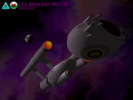 3D scene created by Andrew Hall |
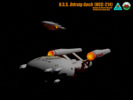 3D scene created by Andrew Hall |
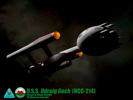 3D scene created by Andrew Hall |
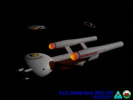 3D scene created by Andrew Hall |
![]() History
History![]()
In 2160, the United Earth (UE) and its allies won an overwhelming victory in their war with the Romulan Star Empire. Mighty UESN task forces spearheaded by third-generation matter/antimatter (M/AM)-powered heavy cruisers stood on the doorstep of the Romulan homeworlds, prepared to lay waste to them. However, by 2161, a treaty had been signed between the UE and the Romulans establishing a demilitarized zone, called the Romulan Neutral Zone (RNZ), entry into which would be considered an act of war. Even greater changes involved the UE and its wartime allies. They had united in a political entity called the United Federation of Planets (UFP), and the war-winning UE Stellar Navy (UESN) had become the core of the Federation's Starfleet.
Owing to the concerns of the Vulcans and other pacifists within the Federation, Starfleet was assigned both exploratory and military roles, unlike the purely military UESN. As a result, the most numerous ships in Starfleet were small, lightly armed exploratory cruisers and scouts of the Daedalus and Comet classes which had been inherited from the UESN. In contrast, only a dozen of the UESN's heavy cruisers (Conqueror class) and fighter-carriers (Yorktown class), designed for long-range attacks on enemy fleet concentrations and star systems, had entered service with Starfleet, the rest having been mothballed, repurposed, scrapped, or sold off to local defense forces. The Federation monitored the RNZ, which lay up to 7 ly antispinward of the prewar border, by a network of system-based and deep-space outposts that probed deeply into Romulan space with powerful subspace sensors. Starfleet was confident that any preparations for a new offensive by the Romulans would be detected long before an attack could be carried out. However, despite the assurances of the keepers of Starfleet's new watchtowers, the UFP knew little or nothing about what was happening on the Romulan side of the border. In fact, it did not even know what the Romulans looked like (and would not know for another century). The only possible conclusion, which even pacifists were forced to accept, was that the Romulans continued to pose a threat to the safety of the Federation.
To meet such a threat, Starfleet desired new ships to replace its Conqueror-class heavy cruisers. Although these extremely capable ships had been constructed no earlier than 2159, their large crew complements and long-range warp drives, which had been required for their original mission of breaching the defenses of the Romulan Star Empire, made them poorly suited for defending the Federation's borders against Romulan attacks. During the war, UESN had spared no expense in constructing and launching large numbers of fast, powerful warships to battle Romulan fleets. Conqueror-class cruisers and second-generation cruisers introduced earlier in the war were designed to operate in large, independent task forces far from friendly starbases. However, stationing such ships along the RNZ to repel a possible Romulan invasion was considered excessive in terms of personnel, fuel, and operating costs. Because current Starfleet doctrine did not call for border-based defensive ships to pursue invading forces across the RNZ and back into Romulan space, the ability to cruise long distances at high speed was considered unnecessary. Instead, what was needed were ships that could quickly intercept enemy raiders and destroy or repel them with an overwhelming barrage of missile and cannon fire. Starfleet hoped that such a powerful force of defensive ships would deter any attacks upon Federation territory.
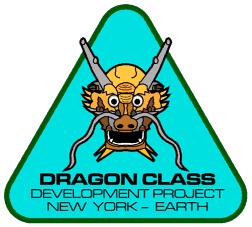
In April 2163 Starfleet's Ship Specifications Board issued a request for proposals for a new class of border-defense heavy cruisers or "heavy interceptors" to be called the Dragon class. The new ships were to have firepower (both missile and beam weaponry) at least 33% greater than that of Conqueror and be able to track, engage, and destroy large groups of enemy ships with the support of ground-based or space-based subspace sensor arrays. Dragons were expected to use many new and improved technologies, such as sensors, computers, damage-control systems, life support, signal suppression, automation, and munitions, that had been under development during and after the war but had not yet been fielded. Specified cruising and maximum speeds were wf 3.4 and wf 4.5, respectively, compared with wf 3.1 and wf 4.2 for Conqueror. Because Dragons were expected to operate within 10 ly of frontier starbases, a capability for long-range cruising without support or refueling was considered unnecessary. Displacement and complement were to be 150,000 tons or less and 430 officers and crew, which were one-third of those of Conqueror (498,000 tons and 1,320 officers and crew). Starfleet hoped that these new single-purpose ships would be less expensive to design, construct, and operate yet be more effective for border defense than the multipurpose cruisers built during the war. The first ship of the new class of 20 ships was to enter service in April 2166.
By December 2163, proposals had been received from 5 builders. In April 2164, the Ship Specifications Board announced the winning design, submitted by Monarch Industries of New York. Monarch's Dragon design was, in effect, a scaled-up version of its Comet class, the light cruiser that had served as the basis of the exploratory Daedalus class. Overall length was 228 m, and the designed displacement was 150,000 tons. The ship's internal spaces were divided into distinct primary and secondary hulls (known at the time as "command" and "service" hulls) which, according to design principles developed by Monarch during the war, allowed each warp factor to be achieved with lower power levels. Unlike that of Comet, however, the primary hull of the Dragon class was oblate rather than ovoid but was still connected to the secondary hull by a thin horizontal neck. The primary hull carried all the ship's weaponry, which comprised 2 forward and 2 rearward missile ports and 4 forward pulse cannons. The primary hull also housed the bridge, computer core, the main navigational deflector, all crew areas, and a rear-facing landing bay for personnel and cargo shuttles. The conical secondary hull extended downward below the primary hull to allow forward clearance of the targeting sensor array. The secondary hull also contained a large cargo-shuttle bay and container storage areas. At the rear of the secondary hull was a vertical tokomak and deuterium tanks to power the 4 impulse-drive thrusters. The AM bottles and the SSWR-II-D1 M/AM reactor, which was a scaled-up version of the slim SSWR-II-D reactor used in the Powhatan class, were placed in a 18-m-wide, 42-m-long cylindrical "warp bustle," which could be detached should the reactor or AM bottles be severely damaged and threaten the survival of the ship. The nacelles, attached to the secondary hull by a pair of 45-degree supports, were 129-m-long Typhoon C1 units, variants of the NPO Energomash Typhoon A-bis nacelles used for Comet.
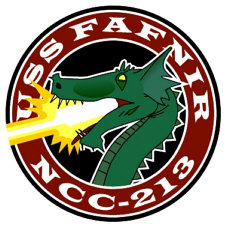
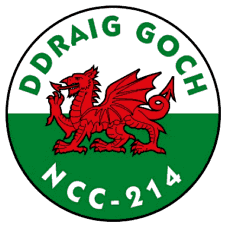
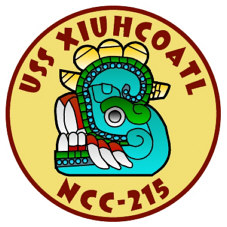
Construction of the lead ship of the class began in August 2164. Work proceeded quickly on the ship's main structure, but numerous problems were encountered as Hull #1 began to be fitted out with her various components, which were supplied by subcontractors and then integrated within the ship's structure. Because Dragon was called upon to have speed, targeting ability, and firepower superior to those of Conqueror but be approximately one-third the size meant that numerous components of the sensor, weapons, and drive systems needed to be developed especially for her. For example, the Broadsword antiship missiles were to have a warhead with an explosive yield of nearly 100 megatons, yet have a speed, range, and accuracy exceeding those of Conqueror's Thunderflash missiles. These requirements necessitated a wider and longer missile housing, which in turn increased the hull space needed to store and launch the missiles, decreased the number of missiles that could be carried, and decreased the amount of space available for other purposes, such as crew spaces or life-support equipment. Similarly, weapons-targeting required integration of the ship's own long-range sensors with ground- or space-based subspace sensors through a large, power-hungry, heat-producing computer core and combat information system.
The problems were compounded by Starfleet's requests in January 2165 for across-the-board performance increases for all ship's systems in response to a new 5-year threat forecast issued by Starfleet Intelligence. According to this forecast, the diffusion throughout the galaxy of Earth-developed technology by means of trade within the UFP and with friendly governments suggested that the Romulans and other potential threat forces would soon possess equipment matching or surpassing the capabilities of Romulan-War-era UESN equipment. Therefore, the capabilities of Dragons would need to leapfrog current technology to ensure that Starfleet would prevail over any possible near-term adversary, either known or unknown. A single Dragon-class ship would be required to be able to track, attack, and destroy 10 enemy vessels cruising at wf 3.5 within a space of 1 cubic light-year. Accordingly, the yields and effective ranges of all weaponry (and associated sensors) were increased by an average of 25%; cruising and maximum speeds were increased to wf 3.6 and wf 4.7, respectively; and the action radius from support bases was increased to 12.5 light-years. However, the new crew size and displacement were only 10% greater than those initially specified. Starfleet was confident that, given sufficient financial support and time, the resourceful military researchers of the Federation would have little trouble developing innovative solutions to the challenge of achieving greater performance without increasing the ship's displacement. The target date for the lead ship to enter service was pushed back 6 months to October 2166.
To meet the new performance requirements, numerous changes were made. To increase the cruising and maximum speeds, a more powerful SSWR-II-D2 M/AM reactor was installed. This new reactor and its housing were significantly larger than those originally planned and had a wider attachment interface with the rear of the secondary hull; therefore, to ensure efficient detachment in emergencies, the reactor and the antimatter bottles were placed in a separate tertiary hull (known at the time as the "reactor hull") connected to the secondary hull by a short, cylindrical, smaller-diameter bridge. In addition, the 129-m-long Typhoon nacelles were replaced by 157-m-long Titan units, which were to be the heaviest, longest nacelles on a Starfleet vessel until the Sabre units mounted on the Pyotr Velikiy and Constitution classes some 75 years later. Firepower was enhanced by the addition of 5 pulse cannons (4 forward in the primary hull and 1 rearward in the neck) and 2 forward missiles ports in the primary hull. Accordingly, the missile complement was increased to 72 (48 offensive and 24 defensive), which could be fired forward in volleys of 12. To increase the range of the weapons-targeting sensor, the length of its resonance tunnel was increased by 25%; in addition, the rearward sensor array behind the M/AM reactor was enlarged. To increase the ship's reconnaissance and attack ranges, the shuttle bay was enlarged to accommodate 5 fighter/scout craft. Together, these changes further decreased the space that could be used for crew quarters, ships stores, and life-support systems.
By mid-2165 rumors began circulating that the Dragon project was in serious trouble. Even before the performance increases requested in January 2165, ships' systems contractors had complained that performance goals were unrealistically high. They complained that the levels of research funding provided were far below those provided during the recent war and were insufficient to secure the staff, equipment, and facilities necessary to develop and manufacture the needed equipment. Furthermore, the more powerful equipment, notably the weapons systems, was considerably heavier and placed enormous strain on the ship's structural members. The more powerful equipment also had greater requirements for energy, heat dissipation, and shielding. Dragon was now 257 m long, with an estimated displacement of 180,000 tons.
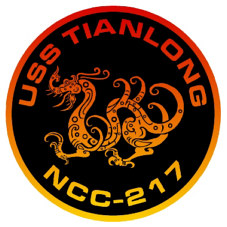
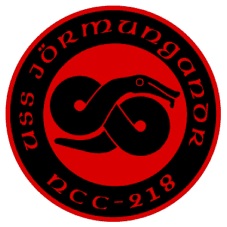
In December 2165 the Dragon class development project was well into its third year. Despite many of the ship's systems functioning only intermittently in an integrated fashion, Hull #1 was christened USS Fafnir (NCC-213) and launched to begin space trials. Because this milestone had finally been reached, construction was authorized to begin on the next 3 ships of the class. However, space trials of Fafnir quickly revealed numerous problems. The most severe involved the weapons and propulsion systems. The first firing of a full 12-missile salvo from the 4 forward missile tubes at an attack speed of wf 4.2 caused the mounts for the primary hull's forward deflector and targeting sensors to flex and become misaligned. The solution lay in a return to the construction dock for additional structural reinforcement and shielding of the missile tubes and deflector mounts. Next, speed runs at high warp factors revealed harmonic flexing originating from the nacelle supports and propagating throughout the length of the ship. The vibrations played havoc with navigation, weapons targeting, and the stability of the subspace field and prevented Fafnir from reaching design speeds despite maximal reactor output. Worse, such vibrations would eventually lead to fatigue, cracking, and failure of the main structural strength members of the ship and, in the worst case, to a sudden, catastrophic loss of spaceframe integrity. Although numerous inertial dampers were placed throughout the ship, the vibrations could not be stopped. The solution lay in the drastic measure of shortening and thickening the neck connecting the primary and secondary hulls and attaching the nacelles to the tertiary hull by means of a second pair of supports. With these modifications, Fafnir was now 247 m long but displaced 194,000 tons.
Because of the Dragon class's numerous developmental problems and mounting costs, in April 2166 the Admiralty and the Federation Council began to consider ending the Dragon program. Under this plan, the lead ship, USS Fafnir, would be retained as a technology demonstrator, and the other 5 hulls under construction would be scrapped. Supporters of Dragon maintained that cancellation of the class would leave the Federation's borders dangerously unprotected should the Romulans or other hostile power choose to attack. True, nothing had been seen or heard of the Romulans for more than 5 years, but the Romulans were considered an inscrutable and unpredictable race that might attack at any time. On the other hand, the defensive role of Dragon might be ably fulfilled by more flexible multirole ships, which could, unlike Dragon, also undertake exploratory, diplomatic and scientific missions. The Admiralty agreed that a final decision on the fate of the Dragon class would be made early in the new year.
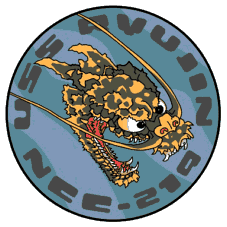
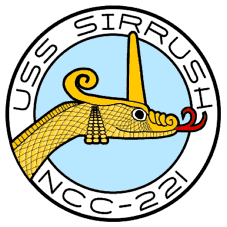
However, by October 2166, the fortunes of the Dragon project seemed to have improved. Most of the outstanding problems were being solved: the lead ship, USS Fafnir, was about to be commissioned by Starfleet; the second and third ships (Ddraig Goch and Xiuhcoatl) were successfully undergoing space trials; the fourth, fifth, and sixth ships (Zmey Gorynych, Tianlong, and Jörmungandr) were about to be launched; and the next 4 ships (Ryūjin, Aži Dahāka, Sirrush, and Zilant) were starting to build. The future now looked bright indeed for the Dragon class. Forty-four months of development were finally rewarded when USS Fafnir entered service with Starfleet's Frontier Defense Fleet on Christmas Day 2166. She was stationed at Starbase Horatio (GJ 1128), 2 parsecs from the RNZ. In war games held at the nearby Starbase Bolivar (Innes' Star) in February 2167, Fafnir, with the help of ground-based and ship-based subspace sensors, successfully detected, engaged, and destroyed 8 of 10 warp drones simulating invading warships; the 2 drones not destroyed were judged to have "returned under fire to enemy territory" and, therefore, not to have achieved their war-game objectives. The good news continued when, later the same month, Ddraig Goch and Xiuhcoatl entered service and joined Fafnir on the Romulan frontier.
Although Starfleet seemed to have obtained precisely the ship it had desired in 2163, by 2167 Starfleet's desires had changed. Dragons were superbly suited for their role of engaging and destroying enemy invasion fleets and had accomplished everything asked of them. Unfortunately, they were poorly suited for any other role. Because Dragons had been designed to operate within 12.5 ly of well-equipped frontier starbases, their range had been sacrificed for high attack speeds and abundant weaponry. In an effort to evaluate the suitability of Dragons for other roles, in July 2167 USS Zmey Gorynych was sent on an extended tour to "show the flag" to friendly governments above the Federation's Beta Comae Berenices colony. Although the tour by the large, impressive warship was well received by the neighboring systems and was considered a public relations success by the Federation Council, the logistical support needed for the cruise was onerous. Clearly, Dragons were unlikely to become independent long-range explorers, which were what the Federation now most desired and needed, without extensive and costly modifications to remove weaponry and install laboratories, scientific equipment, crew quarters, common areas, and long-term life-support systems. With the receding threat of Romulan invasion and the rapid expansion of the Federation's borders, Dragon had quickly become a costly and immobile white elephant. As a result, in November 2167 Starfleet cancelled the final 10 ships of the class before construction had begun.
Despite the class's difficult development, the 10 completed Dragons proved to be rugged and reliable ships. During their careers, they were generally believed to have helped deter Romulan aggression. As the Federation expanded, Dragons were occasionally based at considerable cost where the threat of aggression was deemed highest. However, all Dragons were withdrawn from front-line service by 2180 without ever having fired a shot in anger. Several ships were held in reserve until 2200, and one ship, USS Aži Dahāka, served as a Starfleet Academy training ship into the mid-2260s.
The Dragon-class heavy cruiser USS Jörmungandr (NCC-218) is on display in the Starfleet Museum.
![]() Commissioned Ships
Commissioned Ships![]()
USS Fafnir NCC-213
USS Ddraig Goch NCC-214
USS Xiuhcoatl NCC-215
USS Zmey Gorynych NCC-216
USS Tianlong NCC-217
USS Jörmungandr NCC-218
USS Ryūjin NCC-219
USS Aži Dahāka NCC-220
USS Sirrush NCC-221
USS Zilant NCC-222
![]() Specifications
Specifications![]()
Standard displacement: 194,400 mt
| Overall | 1° Hull | 2° Hull | 2° Hull | Nacelles | |
| Length [m] | 247.28 | 72.76 | 72.13 | 58.90 | 157.61 |
| Beam [m] | 99.20 | 69.54 | 37.33 | 21.80 | 19.56 |
| Draft [m] | 56.70 | 38.10 | 32.50 | 21.80 | 19.56 |
Crew complement: 455 (76 officers, 379 crew)
Weapons: 9 Type VII laser cannons (fixed mounts), 6 missile launchers with 52 Broadsword antiship missiles, 24 Aegis area-defense missiles
Embarked craft: 3 medium cargo/personnel shuttlecraft, 4 light personnel shuttlecraft, 5 fighter/scouts
Warp drive: SSWR-II-D2 spherical cavity M/AM reactor with 2 Titan nacelles
Velocity: wf 3.6, cruise; wf 4.4, supercruise; wf 4.7, maximum
Units commissioned: 10 (20 planned)
![]()